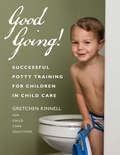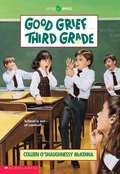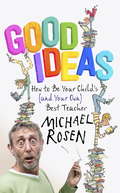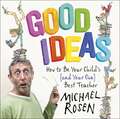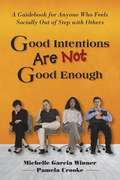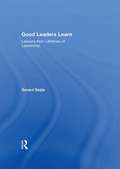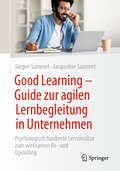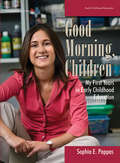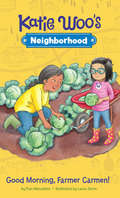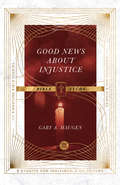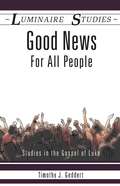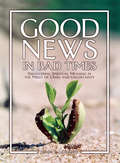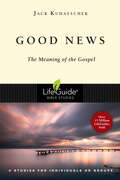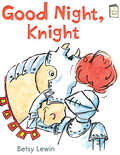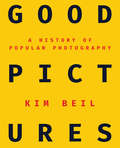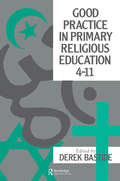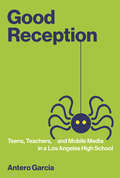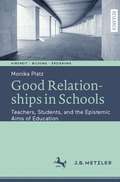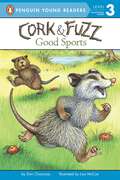- Table View
- List View
Good Going!
by Gretchen Kinnell for the Child Care Council of Onondaga County, Inc.From the author of No Biting comes a comprehensive potty-training guide for child care teachers. Good Going! addresses the issues involved when young children are potty trained in a group setting, such as in the classroom, as well as in the home. Eight chapters offer a healthy perspective for developing consistent policies and successful practices for potty training, as well as guidelines for developing productive partnerships with parents--including sample parent communication tools and detailed resource lists.Gretchen Kinnell is the director of education and training at the Child Care Council in Syracuse, NY. She is also an adjunct instructor at Onondaga Community College and a regular contributor to Syracuse Newspaper's "Partners in Parenting" column.
Good Grammar [Grades 6-12]: Joyful and Affirming Language Lessons That Work for More Students (Corwin Literacy)
by Matthew JohnsonModernize grammar instruction with language lessons that inspire and engage students! Grammar and language instruction has long been, in the words of Brock Haussamen in Grammar Alive!, "the skunk at the garden party of the language arts" that turns many eager learners into disengaged participants. This type of disengagement, and resulting student struggles, have long been the norm, not the exception, when it comes to grammar and language lessons. But why? Why does grammar—something so relevant and essential that we use it in the creation of every syllable we say, write, or think—often end up as one of the dullest and most disconnected parts of the ELA classroom? Good Grammar: Joyful and Affirming Language Lessons That Work for More Students seeks to answer that question and to offer practical, on-the-ground solutions for making grammar and language instruction more accessible, practical, and connected to students’ reading, writing, and most importantly, the deep well of language knowledge they bring with them already. At the core of the book are six key practices for creating language instruction that comes across clearer, sticks better, transfers easier, and ultimately instills a love of language, all while teaching major grammatical concepts. Written by a practicing classroom teacher, this book offers Ready-to-go lessons and a recommended sequence Explanation of essential grammar and language concepts for teachers who need to refresh their own understanding of grammar and language topics and concepts Over a hundred modern, engaging, wide-ranging, and diverse mentor text examples Suggestions on how to introduce important linguistic concepts into secondary classes, including lessons about how language develops; how to define, examine, and celebrate dialects/familects/idiolects; and protocols for discussing concepts like code-meshing and "correctness" Examination of broader trends concerning what works and what doesn’t work in regards to grammar and language instruction, with a goal of giving teachers the tools they need to create their own grammar and language curriculum that engages, inspires, and transfers more easily into student writing and life beyond the classroom walls. The title—Good Grammar—seeks to remind us that grammar doesn’t have to be boring or feel punitive. Instead, it can be a force for good for more students, affirming who they are, honoring the language expertise they bring with them, and helping them to bring their unique voices to the page.
Good Grammar [Grades 6-12]: Joyful and Affirming Language Lessons That Work for More Students (Corwin Literacy)
by Matthew JohnsonModernize grammar instruction with language lessons that inspire and engage students! Grammar and language instruction has long been, in the words of Brock Haussamen in Grammar Alive!, "the skunk at the garden party of the language arts" that turns many eager learners into disengaged participants. This type of disengagement, and resulting student struggles, have long been the norm, not the exception, when it comes to grammar and language lessons. But why? Why does grammar—something so relevant and essential that we use it in the creation of every syllable we say, write, or think—often end up as one of the dullest and most disconnected parts of the ELA classroom? Good Grammar: Joyful and Affirming Language Lessons That Work for More Students seeks to answer that question and to offer practical, on-the-ground solutions for making grammar and language instruction more accessible, practical, and connected to students’ reading, writing, and most importantly, the deep well of language knowledge they bring with them already. At the core of the book are six key practices for creating language instruction that comes across clearer, sticks better, transfers easier, and ultimately instills a love of language, all while teaching major grammatical concepts. Written by a practicing classroom teacher, this book offers Ready-to-go lessons and a recommended sequence Explanation of essential grammar and language concepts for teachers who need to refresh their own understanding of grammar and language topics and concepts Over a hundred modern, engaging, wide-ranging, and diverse mentor text examples Suggestions on how to introduce important linguistic concepts into secondary classes, including lessons about how language develops; how to define, examine, and celebrate dialects/familects/idiolects; and protocols for discussing concepts like code-meshing and "correctness" Examination of broader trends concerning what works and what doesn’t work in regards to grammar and language instruction, with a goal of giving teachers the tools they need to create their own grammar and language curriculum that engages, inspires, and transfers more easily into student writing and life beyond the classroom walls. The title—Good Grammar—seeks to remind us that grammar doesn’t have to be boring or feel punitive. Instead, it can be a force for good for more students, affirming who they are, honoring the language expertise they bring with them, and helping them to bring their unique voices to the page.
Good Grammar for Students (SAGE Essential Study Skills Series)
by Howard JacksonMany students set out in further and higher education with little grounding in the skills required for academic writing. This practical guide will give students a command of grammar, spelling and punctuation, enabling them to improve the quality and accuracy of their writing. The book includes: - the basics of English grammar - how sentences are structured; - help with spelling and punctuation; - tips on avoiding the most common mistakes and pitfalls; - advice on how students can improve their writing in essays, reports and projects. The book is packed with examples to illustrate points and highlight good and bad practice, and contains handy tips and student exercises. An indispensable companion for undergraduate students on any Social Science, Humanities or Arts degree course, Good Grammar for Students is also an ideal text for Study Skills modules at first year undergraduate level across the social sciences. SAGE Study Skills are essential study guides for students of all levels. From how to write great essays and succeeding at university, to writing your undergraduate dissertation and doing postgraduate research, SAGE Study Skills help you get the best from your time at university.
Good Grief... Third Grade
by Colleen O'Shaughnessy MckennaMarsha Cessano, Collette Murphy's neighbor, is determined to be good in third grade -- no messy desk, no temper, and no tricks -- but Roger Friday is making it difficult.
Good Ideas: How to Be Your Child's (and Your Own) Best Teacher
by Michael RosenWe live in a world surrounded by all the stuff that education is supposed to be about: machines, bodies, languages, cities, votes, mountains, energy, movement, plays, food, liquids, collisions, protests, stones, windows. But the way we've been taught often excludes all sorts of practical ways of finding out about ideas, knowledge and culture - anything from cooking to fixing loo cisterns, from dance to model making, from collecting leaves to playing 'Who am I?'. The great thing is that you really can use everything around you to learn more.Learning should be much more fun and former children's laureate, million-selling author, broadcaster, father of five and all-round national treasure, Michael Rosen wants to show you how. Forget lists, passing tests and ticking boxes, the world outside the classroom can't be contained within the limits of any kind of curriculum - and it's all the better for it. Long car journeys, poems about farting, cake baking, even shouting at the TV can teach lessons that will last a lifetime. Packed with enough practical tips, stories and games to inspire a legion of anxious parents and bored children, Good Ideas shows that the best kind of education really does start at home.
Good Ideas: How to Be Your Child's (and Your Own) Best Teacher
by Michael RosenWe live in a world surrounded by all the stuff that education is supposed to be about: machines, bodies, languages, cities, votes, mountains, energy, movement, plays, food, liquids, collisions, protests, stones, windows. But the way we've been taught often excludes all sorts of practical ways of finding out about ideas, knowledge and culture - anything from cooking to fixing loo cisterns, from dance to model making, from collecting leaves to playing 'Who am I?'. The great thing is that you really can use everything around you to learn more.Learning should be much more fun and former children's laureate, million-selling author, broadcaster, father of five and all-round national treasure, Michael Rosen wants to show you how. Forget lists, passing tests and ticking boxes, the world outside the classroom can't be contained within the limits of any kind of curriculum - and it's all the better for it. Long car journeys, poems about farting, cake baking, even shouting at the TV can teach lessons that will last a lifetime. Packed with enough practical tips, stories and games to inspire a legion of anxious parents and bored children, Good Ideas shows that the best kind of education really does start at home.
Good Ideas: How to Be Your Child's (and Your Own) Best Teacher
by Michael RosenWe live in a world surrounded by all the stuff that education is supposed to be about: machines, bodies, languages, cities, votes, mountains, energy, movement, plays, food, liquids, collisions, protests, stones, windows. But the way we've been taught often excludes all sorts of practical ways of finding out about ideas, knowledge and culture - anything from cooking to fixing loo cisterns, from dance to model making, from collecting leaves to playing 'Who am I?'. The great thing is that you really can use everything around you to learn more.Learning should be much more fun and former children's laureate, million-selling author, broadcaster, father of five and all-round national treasure, Michael Rosen wants to show you how. Forget lists, passing tests and ticking boxes, the world outside the classroom can't be contained within the limits of any kind of curriculum - and it's all the better for it. Long car journeys, poems about farting, cake baking, even shouting at the TV can teach lessons that will last a lifetime. Packed with enough practical tips, stories and games to inspire a legion of anxious parents and bored children, Good Ideas shows that the best kind of education really does start at home.(P)2014 John Murray Press
Good Intentions Are Not Good Enough
by Michelle Garcia Winner Pamela CrookeBook geared to young adults and adults on why Social Thinking/social skills are important in the workplace, community, and in relationships.
Good Leaders Learn: Lessons from Lifetimes of Leadership
by Gerard SeijtsHow do leaders learn to lead? How do leaders set themselves up for success? This book explores the real-life experiences of a wide variety of leaders from different industries, sectors, and countries to bring to light new lessons on the importance of life-long learning. Consisting primarily of a series of probing interviews, Good Leaders Learn presents the challenges, triumphs, and reflections of 31 senior and high-profile leaders, offering insight into how they learned to lead during their careers. The book pulls important and useful perspectives into a robust theoretical framework that includes the importance of innate curiosity, challenging oneself, risk-taking, and other key elements of good leadership. With practical insights complemented by the latest leadership research and theory, this book will help current and potential leaders to build a solid foundation of the leadership qualities vital to their continuing success.
Good Learning - Guide zur agilen Lernbegleitung in Unternehmen: Psychologisch fundierte Lernansätze zum wirksamen Re- und Upskilling
by Jürgen Sammet Jacqueline SammetGood Learning - kontinuierliches Lernen und gezielte Kompetenzentwicklung - mit agiler Lernbegleitung zu wirksamem Re- und UpskillingDurch konsequente Fort- und Weiterbildung gelingt die Anpassung an die sich immer schneller wandelnden Anforderungen. Doch viele Lerntrends halten nicht, was sie versprechen und versanden wirkungslos.Fern von flüchtigen Moden vermittelt Ihnen dieses Buch bewährte, wissenschaftlich fundierte Lernansätze. Erfahren Sie, wie Sie mit dem Konzept der Agilen Lernbegleitung die drei entscheidenden E`s im betrieblichen Lernen umsetzen: Effektivität, Effizienz und Empowerment.Dieses Buch vermittelt Ihnen handfeste Anwendungsideen für eine zeitgemäße Learning Experience. Damit „Good Learning“ gelingt. Zielgruppen:HR-Verantwortliche, die innovative Lernstrategien implementieren möchten.Learning Professionals, die nachhaltige Lernkulturen schaffen wollen.Trainer:innen, die ihre Angebote an die moderne Lernlandschaft anpassen möchten.Führungskräfte, die die Entwicklung der Mitarbeitenden zielgerichtet unterstützen wollen.Teammitglieder, die für das Team-Lernen verantwortlich sind.Fachexpert:innen, die ihre Expertise weitergeben möchten.
Good Moon Rising
by Nancy GardenLambda Literary Award winner Good Moon Rising is about two young women who fall in love while rehearsing a school play, realize they're gay, and resist a homophobic campaign against them.
Good Morning, Children: My First Years in Early Childhood Education
by Sophia PappasBased on her popular Pre-K Now blog, Sophia Pappas' book Good Morning, Children provides an up-close and personal view of the challenges and successes of a beginning teacher. The book describes daily encounters with students, family members, and administrators; reflects on the state of early childhood education in America; and celebrates the ways the pre-K teacher can help prepare every child to succeed in both school and life. In chronicling the successes and failures of her first years as an early childhood educator, Ms. Pappas, a veteran of the Teach For America education program, covers a range of topics that both new and experienced educators face in the early childhood classroom. Among other important issues, Ms. Pappas: * describes the activities, lessons, and teaching techniques she used to help her students learn and grow. * provides smart and witty insights about the importance of classroom preparation, for both the school year and each individual day.* shares ideas about how to interact successfully with over- and under-involved parents and family members, highlighting the critical importance of family involvement to each child's success. * stresses the significance of listening and adjusting, not only to the needs of the children in your care and to the family members of those children, but, just as important listening and adjusting to your own needs as an educator.
Good Morning, Farmer Carmen! (Katie Woo's Neighborhood)
by Fran ManushkinKatie is sure it would be fun to be a farmer. All you have to do is plant seeds and watch them grow. Pedro's aunt is a farmer, and she works very hard. Katie will find out just how hard farmers work when she and Pedro help get ready for a day at the farmer's market. Katie loves her community and that love is shown in Katie Woo's Neighborhood, an early chapter book series by author Fran Manushkin.
Good News About Injustice Bible Study (IVP Signature Bible Studies)
by Gary A. HaugenGod's heart for justice resonates through Scripture. With Good News About Injustice, Gary Haugen helped thousands of Christians catch this vision and be empowered to join God's work around the world. Now the Good News About Injustice Bible Study guides you deeper into biblical texts and themes that have informed Haugen's groundbreaking book. These five easy-to-use studies will challenge and enrich your understanding as you encounter what God's Word says about justice and what it means for you today. As companions to the IVP Signature Collection, IVP Signature Bible Studies help individuals and groups explore and apply biblical truths found in classic books. Each session features quotations from Good News About Injustice matched with Scripture passages, reflection questions, and application ideas that will equip readers to connect the text to their own lives. A leader's guide is also included.
Good News For All People: Studies In The Gospel Of Luke
by Timothy J. Geddert“Watch out Rome, the Christians are coming! Your powerful armies, your so-called Pax Romana – these are no match for the power of love and self-sacrifice that Jesus unleashed when he came to bring God’s salvation, establish God’s reign, and send his followers into the world to proclaim and to embody the greatest news the world has ever known. No earthly kingdom can stand in the face of such good news.” So we might summarize the message of Luke’s Gospel. It is a message that spreads hope, that transforms life. And it speaks as powerfully to the downtrodden, to the empires, and to the ordinary folk of our world as it did 2000 years ago. We are invited to listen, to study, and to pass on the good news. It also has the power to change our world. Good News for All People follows the Luminaire Studies pattern of recording The Text, identifying the literary form and train of thought in The Flow and Form of the Text, exploring and expounding on this passage in The Text Explained, building a bridge between the original context of Romans and our own day in the Implications of the Text for Today and provoking reflection in the Personal Reflection questions. Luminaire Studies are designed for the discerning reader and student of the Scriptures. Written in narrative style, the material is suitable for personal study or group interaction. Join Tim Geddert and be inspired and challenged by Luke’s amazing portrait of Jesus and presentation of Jesus’s mission and ours.
Good News in Bad Times
by John LozanoHome foreclosures, job losses, sudden illnesses crisis and tragedy surround us in our everyday lives. Some people shrink away from them, become depressed and pessimistic about life. Others become angry and turn away from religion. In his debut book, author John P. Lozano offers a different solution: Use crisis and uncertainty to grow in both faith and personal strength. In Good News in Bad Times, Lozano draws from his wealth of personal life experience, and from the lives of those he has met on his faith journey, to prove that with crisis comes opportunity opportunity to open our eyes and arms to God's strength. Written in an accessible style and designed for Christians of all denominations, this book will be a timeless companion for all readers wherever they may be on their own journeys of faith
Good News: The Meaning of the Gospel (LifeGuide Bible Studies)
by Jack KuhatschekThis nine-session LifeGuide Bible Study explores not only the question, "What must I do to be saved?" but also will help groups understand the meaning of the good news: that is, the incredibly broad scope of what God has done, is doing, and will do in the future to reconcile all things to himself through Jesus Christ. For over three decades LifeGuide Bible Studies have provided solid biblical content and raised thought-provoking questions—making for a one-of-a-kind Bible study experience for individuals and groups. This series has more than 130 titles on Old and New Testament books, character studies, and topical studies.
Good Night, Knight (I Like to Read)
by Betsy LewinKnight and Horse follow their dreams . . . but will they find the treasure they're after? Find out in this Guided Reading Level F Book. Clank! Clank! Clip-Clop! Knight and his faithful Horse are on a quest to find the golden cookies of Knight's dreams. Far and wide they travel, trotting through the land in search of treats-- but the cookies are nowhere to be found. Finally they return home, where a surprise in the kitchen awaits to reward their valiant quest. With simple text featuring repetition and predictable patterns, this Knight's tale is ideal as a read aloud, or for emergent readers to tackle on their own. Sketchy, energetic illustrations by Caldecott Honoree Betsy Lewin add humor and detail as Knight, who never takes off his signature armor, peers into trees and into bushes in search of his golden prize,. The award-winning I Like to Read® series focuses on guided reading levels A through G, based upon Fountas and Pinnell standards. Acclaimed author-illustrators--including winners of Caldecott, Theodor Seuss Geisel, and Coretta Scott King honors—create original, high quality illustrations that support comprehension of simple text and are fun for kids to read with parents, teachers, or on their own! For kids who've mastered the earlier levels, Level F readers feature longer, more varied sentences, and encourage kids to decode new multi-syllable words in addition to recognizing sight words. Stories are more complex, and the illustrations provide support and additional detail.
Good Pictures: A History of Popular Photography
by Kim BeilA picture-rich field guide to American photography, from daguerreotype to digital. We are all photographers now, with camera phones in hand and social media accounts at the ready. And we know which pictures we like. But what makes a "good picture"? And how could anyone think those old styles were actually good? Soft-focus yearbook photos from the '80s are now hopelessly—and happily—outdated, as are the low-angle portraits fashionable in the 1940s or the blank stares of the 1840s. From portraits to products, landscapes to food pics, Good Pictures proves that the history of photography is a history of changing styles. In a series of short, engaging essays, Kim Beil uncovers the origins of fifty photographic trends and investigates their original appeal, their decline, and sometimes their reuse by later generations of photographers. Drawing on a wealth of visual material, from vintage how-to manuals to magazine articles for working photographers, this full-color book illustrates the evolution of trends with hundreds of pictures made by amateurs, artists, and commercial photographers alike. Whether for selfies or sepia tones, the rules for good pictures are always shifting, reflecting new ways of thinking about ourselves and our place in the visual world.
Good Practice In Primary Religious Education 4-11
by Derek BastideIntended for the use of primary head teachers, class teachers and teachers in training, this book examines the requirements of the 1988 Education Reform Act in respect of religious education in schools. It offers guidance on ways in which religious education can be developed successfully.
Good Reception: Teens, Teachers, and Mobile Media in a Los Angeles High School (Digital Media and Learning)
by Antero GarciaA year in the life of a ninth-grade English class shows how participatory culture and mobile devices can transform learning in schools. Schools and school districts have one approach to innovation: buy more technology. In Good Reception, Antero Garcia describes what happens when educators build on the ways students already use technology outside of school to help them learn in the classroom. As a teacher in a public high school in South Central Los Angeles, Garcia watched his students' nearly universal adoption of mobile devices. Whether recent immigrants from Central America or teens who had spent their entire lives in Los Angeles, the majority of his students relied on mobile devices to connect with family and friends and to keep up with complex social networks. Garcia determined to discover how these devices and student predilection for gameplay, combined with an evolving “culture of participation,” could be used in the classroom.Garcia charts a year in the life of his ninth-grade English class, first surveying mobile media use on campus and then documenting a year-long experiment in creating a “wireless critical pedagogy” by incorporating mobile media and games in classroom work. He describes the design and implementation of “Ask Anansi,” an alternate reality game that allows students to conduct inquiry-based research around questions that interest them (including “Why is the food at South Central High School so bad?”). Garcia cautions that the transformative effect on education depends not on the glorification of devices but on teacher support and a trusting teacher-student relationship.
Good Relationships in Schools: Teachers, Students, and the Epistemic Aims of Education (Kindheit – Bildung – Erziehung. Philosophische Perspektiven)
by Monika PlatzThe relationship between teacher and student is an important element of school education and as such irreplaceable: If we want schools to be good places for those who teach and learn there, we must make sure that the educational relationships between teachers and students are good, too.In research about school education, surprisingly little attention is paid to the normative dimension of the relationship between teacher and student. This lacuna points to a desideratum in the philosophy of education: More should be said about the normative structure of the teacher-student relationship, its role in teaching and learning, and its final value for teacher and student.Answering these fundamental philosophical questions is the core of this book. It offers a normatively rich concept of a good teacher-student relationship that is based on the analysis of two major relationship goods: trust and care. Moreover, the book explains the instrumental value of a good educational relationship for the student’s achievement of epistemic aims of school education as well as the final value of such a relationship for teacher and student.
Good Sexual Citizenship: How to Create a (Sexually) Safer World
by Ellen FriedrichsMost of us want to be decent people in the world. Yet when it comes to sex, we so often stumble and contribute to sexual injustice. Think about it: are we really still blaming victims of sexual assaults? Can it truly be that there is a gender based orgasm gap? Are we actually labeling people based on the kind of sex they do or don&’t have? Why do we insist on questioning if sex is consensual when someone&’s passed out drunk? Our society is undergoing an evolution, and we should take this as a call to action to ensure that all people, regardless of gender identity, sexual orientation, ability, age, ethnicity, race, religion, or social class, are treated as humans worthy of respect. Good Sexual Citizenship asks us all to break down sexual hostility and build up something better. To promote understanding and empathy, Friedrichs includes a factual and historical backdrop covering gender disparities, women&’s rights, sexual violence, prevention, and sex education, and challenges readers to use this insight, along with guided exercises, to examine their own potential for &“good sexual citizenship.&” Covering topics like consent, sexual assault, pleasure, double standards, casual sex, hook-up culture, and teen sex, she provides us with tools to navigate societal messages, sexually hostile climates, stereotypes, and outdated mentalities.
Good Sports (Cork and Fuzz #3)
by Dori ChaconasCork is a short muskrat who likes to win at games. Fuzz is a tall possum who also likes to win at games. Two best friends. Both like to win. What will happen when they play games against each other?
